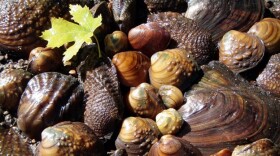A few months ago in another Field Notes episode, I described how my colleague Gretchen Gerrish, and I are trying to figure out why so many wild rice populations are failing. Swans, who munch on wild rice long before it makes flowers or makes seeds, seem to be causing significant damage to the rice. Swans may not be the most important factor in the decline of wild rice, but there is no doubt that the number of swans has increased on our Northwoods lakes. How did this happen?
During the 2021 WI Lakes Partnership’s “Wisconsin Water Week”, Sumner Matteson of the WDNR gave a superb talk on the fabulously successful recovery of trumpeter swans in Wisconsin. Though Father Marquette reported seeing swans back in 1673, the swans were decimated in Wisconsin by Europeans who killed them for their meat or feathers and other frivolous uses.
In 1989, Sumner Matteson and a fleet of collaborators embarked on a plan to achieve an audacious goal of establishing 20 nesting pairs of swans in Wisconsin by 2000. They would fly to Alaska, where trumpeter swans were abundant and reproducing well. They would visit two different areas in alternate years to minimize the effect on the Alaskan swan population. They would steal all but two eggs out of each nest they found with the goal of bringing 50 eggs back to Wisconsin each year. A mother swan leaves the nest occasionally to feed, covering up her eggs with some vegetation to keep them warm. Sumner and his fellow egg thieves waited until the mom was absent and then got to work. To make sure the eggs they brought back had a good chance of hatching, and to make sure the eggs left behind were also healthy, every egg in the nest was quickly candled to determine if it was fertilized and viable.
The first year they successfully brought back their goal of 50 eggs, with volunteers flying them around Alaska and others flying them to and from Wisconsin. The pilfered eggs were incubated and hatched at the Milwaukee Zoo. Sumner and his team returned to Alaska every year from 1989 through 1997, where they collected a total of 385 eggs, and hatched 356 babies.
So far so good. But what were they going to do with the hatchlings?
They had three plans. The first, and most successful, called Decoy Rearing, was largely the idea of UW-Madison professor Stan Temple. He created an artificial swan that could be pulled up and down an inside corridor using a pulley. As soon as the cygnets hatched, they were placed in the corridor where the dummy swan led the babies to pans of mealworms to eat. After a few days, the cygnets were transported to wetlands in northern and central Wisconsin, where camouflaged University of Wisconsin student interns in float tubes continued to manipulate the life-size swan decoy, leading the cygnets around to help them feed. The other two plans differed, but in both the young were relocated to selected Wisconsin wetland sites.
The researchers were extremely careful about where they released the birds. Among other criteria, there could be no waterfowl hunting or power lines but there must be abundant submerged aquatic vegetation and extensive nearby wetlands.
The next big test was whether the young swans would migrate. Swans usually fly as a family unit, so this was a big uncertainty. The other waterfowl in the area – the ducks and geese – had all flown away that first year, but the swans remained. Finally, after about 15 weeks, the young decoy-reared swans from that first year took wing and flew almost as far south as Dallas, Texas.
Finally, they had to monitor their results. For many years they visited the wetlands where the birds had been released, and with aerial assistance they surveyed all the swans. As the number of nests grew, they relied on aerial surveys exclusively, flying along transects that were 30 miles long by ¼-mile wide.
So did they make their goal? By 2000, Sumner Matteson and his corps of collaborators had 44 breeding pairs, more than double their goal. They were up to 253 nests in 2014, and today, there are about 13,000 adult swans in Wisconsin. While there are many in Vilas and Oneida counties, the majority of swans in Wisconsin are in NW Wisconsin in the Crex Meadows area and in Polk County.
What does this mean for my poor wild rice? Well, there is no denying this was an amazing achievement for Sumner Matteson and the swans, so how could I possibly complain? And wild rice coexisted with swans before the Europeans wiped them out. So, while I am sure the swans will continue to damage some of the wild rice, likely the rice will survive. I just hope we can solve some of the other problems faced by wild rice in the Northwoods.









